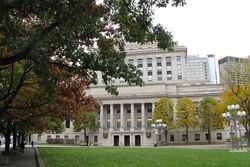Old Buildings Hold Retrofit Challenges for the Construction Industry
The decision to demolish or rehabilitate older buildings is one that communities face with increasing frequency. It’s a trend that significantly impacts the construction industry and the nation’s economy as a whole.
According to a study underwritten by the Mechanical-Contractors Association of America (MCAA), renovation and rebuilding of structures in cities across the country are among the current top five key trends in the mechanical industry.
"During the next 10 years, the renovation of 1960s-era public buildings and infrastructures will comprise a large portion of the commercial construction market," said Atul Dighe, once principal and senior futurist with Social Technologies, LLC, the firm that conducted the study. Meanwhile, developers scramble to take advantage of a renewed demand for downtown housing in major cities throughout the country—another important driver in this trend.
Financial & Environmental Incentives
City planners take heed – this is one real estate trend that offers multi-faceted economic and environmental benefits. By renovating older, existing buildings, communities wisely maximize their investment in existing infrastructures. Furthermore, rehabilitating older structures helps decrease the nation’s dependence on fossil fuels, reduces the carbon emissions associated with demolition and new construction, and lessens the burden on landfills.
Renovating buildings with historic significance can be especially attractive economically. At present, the federal government offers a 20 percent investment tax credit for the rehabilitation of certified historic buildings. Having a state program increases the use -- and the economic impact -- of the federal rehabilitation tax credit program. As an example, once Rhode Island offered a state tax credit, rehabilitation projects leveraged $78 million in federal historic tax credits over a five-year period, an increase of more than 700 percent!
Historic renovation also requires more skilled labor than new construction. Thus, workers on rehabilitation projects earn higher wages and pay more income tax, ultimately increasing federal and state revenue.
 Old Buildings Create Unusual Mechanical Challenges
Old Buildings Create Unusual Mechanical Challenges
Of course, bringing older buildings in line with modern functionality isn’t easy. The structural heft and architectural significance of older, historic buildings frequently creates roadblocks for the contractor or engineer trying upgrade the building’s efficiency, comfort, and fire safety. Making new HVAC systems “fit” into an old envelope often involves creative use of space. That’s where mechanical creativity and flexible componentry can make all the difference.
This was certainly the case during a renovation of Assisi Heights, a historic convent in Rochester, Minnesota. The fortress-like structure left limited space and access for 110 new fan coil units that had to be installed above the ceiling in a hallway. In this case, Belimo’s VS and VSS Series ball valves and actuators were an important space-saving strategy that helped maintain the aesthetic integrity of the building.
a historic convent in Rochester, Minnesota. The fortress-like structure left limited space and access for 110 new fan coil units that had to be installed above the ceiling in a hallway. In this case, Belimo’s VS and VSS Series ball valves and actuators were an important space-saving strategy that helped maintain the aesthetic integrity of the building.
 Similarly, a space-saving Belimo strategy was applied to a renovation of the historic Mary Baker Eddy Library in Boston, Massachusetts. Here, angle union valves, actuators, and linkages were customized by Belimo to fit onto numerous, original steam heat radiators. This seemingly minor detail allowed the library to leave original mahogany woodwork and marble in tact at this historic facility.
Similarly, a space-saving Belimo strategy was applied to a renovation of the historic Mary Baker Eddy Library in Boston, Massachusetts. Here, angle union valves, actuators, and linkages were customized by Belimo to fit onto numerous, original steam heat radiators. This seemingly minor detail allowed the library to leave original mahogany woodwork and marble in tact at this historic facility.
Want to learn more about how Belimo valves, valve actuators, and damper actuators play a key role in building renovations and retrofits? Sign up for the Belimo newsletter.

